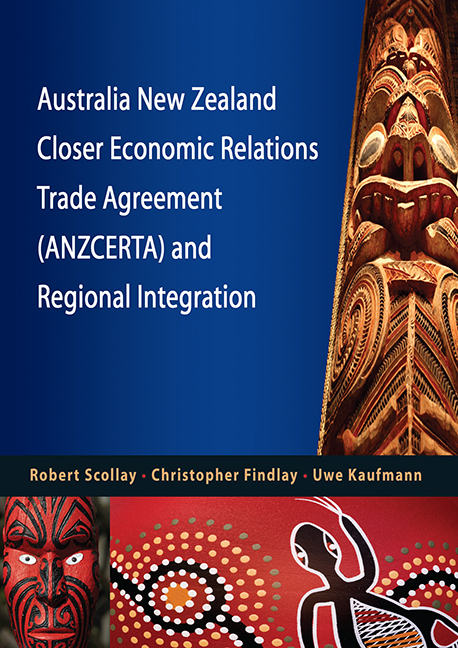Book contents
- Frontmatter
- Contents
- Foreword
- Australia New Zealand Closer Economic Relations Trade Agreement (Anzcerta) and Regional Integration
- Executive Summary
- 1 Introduction
- 2 Background
- 3 Pre-ANZCERTA Trade Arrangements
- 4 Early Years of ANZCERTA
- 5 Consolidation of ANZCERTA
- 6 Deepening Integration
- 7 Pursuit of a Single Economic Market (SEM)
- 8 Further Monetary Integration: A Monetary Union?
- 9 The Economic Effects of ANZCERTA
- 10 Conclusion
- References
- About the Authors
8 - Further Monetary Integration: A Monetary Union?
from Australia New Zealand Closer Economic Relations Trade Agreement (Anzcerta) and Regional Integration
Published online by Cambridge University Press: 21 October 2015
- Frontmatter
- Contents
- Foreword
- Australia New Zealand Closer Economic Relations Trade Agreement (Anzcerta) and Regional Integration
- Executive Summary
- 1 Introduction
- 2 Background
- 3 Pre-ANZCERTA Trade Arrangements
- 4 Early Years of ANZCERTA
- 5 Consolidation of ANZCERTA
- 6 Deepening Integration
- 7 Pursuit of a Single Economic Market (SEM)
- 8 Further Monetary Integration: A Monetary Union?
- 9 The Economic Effects of ANZCERTA
- 10 Conclusion
- References
- About the Authors
Summary
Given the degree of economic integration achieved between Australia and New Zealand, it is perhaps natural that the possibility of a monetary union between Australia and New Zealand should have been considered. Interest in this issue has been confined almost entirely to New Zealand. Little interest has been evident in Australia, perhaps because of the assumption that monetary union would necessarily involve the adoption by New Zealand of the Australian currency, and that the associated adjustment issues would be primarily a matter for consideration by New Zealand rather than Australia.
In New Zealand a substantial report on the issue was produced in 2000 (Grimes et al. 2000), and there have been a number of further publications dealing with the issue both by Grimes and by economists at New Zealand's Reserve Bank (see, for example, Grimes 2005, Bjorksten 2001, and Hunt 2005). This literature is reviewed by Lloyd and Song (2006). Essentially two possibilities have been under consideration: dollarization, whereby the New Zealand Government unilaterally adopts the Australian dollar as its currency, and a formal monetary government, whereby the two governments would jointly adopt a single currency with a single central bank and monetary policy. In the latter case it is typically assumed that the single currency would in practice be the Australian dollar and that the Australian central bank would assume the role of central bank for both countries.
In summarizing research on the issue, Lloyd and Song (2006) note that analysis has generally concluded that neither the benefits nor the costs of monetary union are likely to be large for New Zealand, although Grimes et al. (2000) did mount a case for the adoption by New Zealand of the Australian dollar as its currency (with the US dollar as a possible alternative). One Australian study of the issue, by Crosby and Otto (2002), concluded that monetary union is not in Australia's interest. Politicians have generally been cautious in discussing the issue, perhaps mindful of nationalistic sentiment in both countries.
- Type
- Chapter
- Information
- Australia New Zealand Closer Economic Relations Trade Agreement (ANZCERTA) and Regional Integration , pp. 68 - 70Publisher: ISEAS–Yusof Ishak InstitutePrint publication year: 2010

